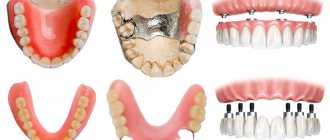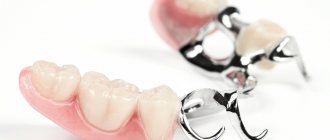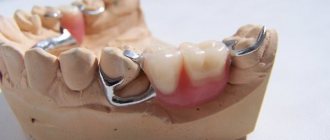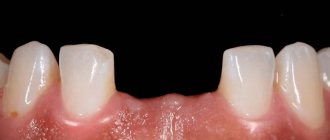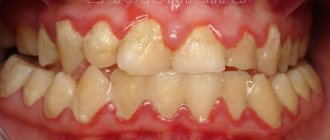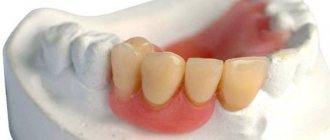Diastema and trema - what is it?
The gap between the teeth is called a diastema. It occurs between the central incisors. Most often found on the upper jaw. With diastema, the gap between the front teeth reaches up to 10 mm.
Trema is similar to a diastema, but is expressed in spaces not only on the front, but also on the remaining incisors located in the mouth. The size of the trema does not exceed 2 mm.
Gaps between teeth: why they occur and how to cure them
Currently, dental clinics provide a wide range of services to improve the aesthetics of a smile. Using modern technologies, specialists carry out high-quality whitening, installation of veneers, and restoration of missing teeth through prosthetics. For patients who contact a specialist with pathologies such as diastema or trema (also called “gaps between teeth”), there are also several treatment options. From today's article you can learn in detail about the differences between these pathologies and how to correct them.
Types of diastemas
Dentists distinguish several types of diastemas:
- False. Usually a gap appears between the teeth of a child during the appearance of primary incisors. There is no need to see a dentist. The gap will disappear on its own after the permanent incisors cut through.
- True. In the absence of other defects, diastema appears in adolescents, when primary dental units are replaced by permanent ones.
- Physiological trema. Appears during the growth of the jaw bones.
- Pathological trema. Occurs in patients with permanent teeth after gum disease or bone atrophy.
People who develop gaps in their teeth often experience communication problems that affect their careers and lives.
To understand how to close the gap between the front teeth, you need to understand the classification of diastemas:
- Parallel. The gap between dental units is no more than 4 mm;
- Triangular. The dimensions are larger than those of the parallel one, it has the shape of a triangle. In some cases, the apex is located near the frenulum, and in others, near the border of the crowns. The reason is the formation of an extra incisor.
What to consider when installing an implant
It is quite difficult to accurately determine the ideal distance between the implant and the tooth; moreover, there are no unambiguous values; each time it is necessary to determine the place where the pin is screwed in individually.
The distance between the tooth and the prosthesis is affected by:
- anatomical features of the jaw bone and teeth;
- location of the tooth being restored;
- implant type and model;
- implant parameters (diameter, length, etc.).
After determining the drilling point, it may be difficult to access the established site, especially if the back teeth are being restored. The situation can be complicated by insufficient visibility, reduced mouth opening, pathologies of the jaw bone tissue, displacement of the drill during operation, etc. Such difficulties can lead to incorrect formation of the hole.
Why is an unclosed diastema dangerous?
If a diastema appears, you need to contact your dentist for help in eliminating it. The orthodontist will tell you why there is a gap between the teeth and whether it can be corrected. If the anomaly is caused by serious changes in the structure of the jaw, then the orthodontist will examine it using X-ray equipment or a CT scanner.
If the situation is unfavorable, the doctor will offer treatment options. If you leave the diastema, gum disease may appear, “pockets” may form in the periosteum, and incisors may fall out prematurely. Pathology affects pronunciation. A person pronounces hissing and whistling sounds worse.
Prices for treatment for three
The cost of treatment for three teeth depends on the nature of the pathology and the chosen direction - orthopedic or orthodontic:
| Ceramic veneer for 1 tooth | From 15,000 rubles |
| Zirconium veneer for 1 tooth | From 20,000 rubles |
| Lumineer for 1 tooth | From 40,000 rubles |
| Artistic tooth restoration | From 3,500 rubles |
| Installation of metal braces | From 80,000 rubles |
| Installation of ceramic self-ligating braces | From 110,000 rubles |
Trema between teeth does not appear just like that: most often they are associated with bite defects that must be corrected. Otherwise, the patient will face such unpleasant consequences as impaired diction, distortion of facial features, difficulty chewing food, a tendency to develop periodontal diseases, abrasion of tooth enamel, regular injury to soft tissues, and even disruption of the gastrointestinal tract.
How to remove a gap between teeth
Technologies in modern orthodontics help in the treatment of diastema. To find out how to remove a gap between teeth, the patient needs to contact a specialist who, after analysis, will prescribe treatment. In some cases, it is impossible to do without surgical correction, and in others, without veneers that hide the aesthetic defect.
Diastema is eliminated in the following ways:
- Surgical plastic surgery. Surgical correction is used alone or together with other treatments. When eliminating diastema in children, the tension of the frenulum decreases, allowing the incisors to take the correct position. If excessive set of incisors affects the gaps between the teeth, braces or orthodontic aligners will remain the only treatment option.
- Implantation. With this pathology, it is not always possible to straighten the teeth. If they are too tilted or rotated, the orthodontist will suggest removing them or replacing them with an implant. The procedure for replacing with an implant will not cause difficulties due to the short period of time after the removal of the dental unit.
- Braces. Often used to solve orthodontic problems. The advantages of braces are their high efficiency and the ability to install them on children and adults. Young patients under the age of 20 get rid of gaps faster due to the growth characteristics of the dental system. In older people, the correction lasts for several years. When wearing braces, you must visit the orthodontist at the frequency specified by him. You cannot remove them yourself. After completing treatment with braces, the doctor prescribes the use of mouth guards or plates to consolidate the result.
- Crowns. If the tooth roots do not need to be expanded, then the gap is closed with crowns. Veneers are placed on adjacent incisors to hide the transverse dimension of the central incisors.
- The plates are used in the treatment of diastema in childhood. The jaw has not yet formed; it does not require much effort to correct it. The plates are placed on one or two jaws, they put pressure on them, moving them to the desired position.
- Mouthguards are covers that are placed over the incisors. They are transparent and do not cause discomfort or pain when worn.
We answered questions about what a gap between teeth is called and what to do when it appears. Diastemas and threes must be gotten rid of when they appear. Otherwise, gum problems and tooth loss are possible. If metal braces are the solution for a particular case, the price will be clarified on our website in the appropriate section, or at an appointment with an orthodontist.
How to deal with trema?
The good news is that trema can be corrected. First of all, the dentist examines the patient’s teeth, determines the cause of the defect, and then prescribes treatment. For example, if an open bite is to blame, you need to start by correcting this pathology.
In general, in modern dentistry the following methods are used to treat three:
- artistic dental extensions;
- special orthodontic devices;
- braces;
- mouth guards;
- veneers and lumineers;
- installation of a crown.
The dentist will determine which of these methods is right for you. The main thing is not to neglect the problem and seek help from a specialist in time. After all, if the external manifestation of trema can be made your highlight, then dental diseases can hardly be called a plus.
Reviews
Many people who have encountered the problem of trema formation note braces as one of the most gentle, does not cause discomfort while wearing, and effective ways to eliminate the defect.
What do you think is the most effective method of solving this problem? Leave your feedback on this matter in the comments to the article.
If you find an error, please select a piece of text and press Ctrl+Enter.
Tags: teeth extensions
Did you like the article? stay tuned
Causes of gaps between teeth
Let's take a closer look at the prerequisites for the occurrence of the pathologies in question. The following phenomena are usually considered to be the causes of diastema:
- physiologically abnormal development of the labial frenulum: a shortened frenulum is attached below the upper part of the incisors (upper jaw), and on the lower jaw the frenulum can be attached higher. Because of this, the lateral surfaces of the incisors cannot touch, a defect appears,
- genetic predisposition: if a close relative has a gap, then there is a high probability of the pathology manifesting in descendants,
- bad habits: thumb sucking, illiterate breastfeeding, the use of pacifiers and non-orthodontic pacifiers can provoke the appearance of a gap between the front teeth.
Despite the fact that a diastema is, in fact, a type of trema, the latter can appear due to the following reasons (the previous ones, accordingly, also cannot be excluded):
- small size of teeth against the background of strong development of the jaw: because of this, gaps appear in the dentition,
- removal or loss: if a prosthesis or implant is not installed in a timely manner, elements may spread along the row and, as a result, gaps may appear,
- hereditary factor: this pathology can again be transmitted from generation to generation.
Interesting fact! It is known that diastema - a gap between the front incisors - is transmitted from parents to children in 80% of cases.
Correction of three between teeth
Although we talk about all these dental problems as the calling cards of many stars, even more of them still decide to correct dental pathology and eliminate dental problems. Cristiano Ronaldo, for example, benefited from treatment for trema. Is not it?
Treatment of such a cosmetic defect usually requires the complex work of a group of specialists and takes quite a long time (we are talking here about many months, up to a year and a half). But the result, as in the case of Ben Affleck, is superb; he underwent treatment even before he became a mega star:
Zac Efron didn’t think long about his diastema and eliminated it in his youth:
In the case of open bite, progenia, prognathia, treatment of the main anomalies by correcting the dentition causes their elimination.
Doctors do not recommend cosmetically eliminating trema without treating the underlying pathology. Otherwise, a relapse will not be long in coming; an incorrect bite leads to excessive stress on the temporomandibular joint (TMJ), which poses an additional danger in adulthood. That is, only after leveling the malocclusion will it be possible to engage in cosmetic restoration.
The reasons for the appearance of pathological three
- edentulism;
- anomaly in the size and shape of teeth (small subulate teeth) and anomaly in their location;
- biting the tongue, lips;
- thumb sucking, pencil sucking and other bad habits. This also leads to an open bite in adulthood.
- wide, low-attached frenulum of the upper lips;
- excessive use of pacifiers in infancy. Also, in addition to the formation of a trema, it is also a candidate for an open bite
- the absence of some teeth due to caries or periodontitis.
Negative effects of tooth decay on health
Trems are not only a cosmetic defect. Because of them, the edge of the gum is often injured by food in the area between the teeth, which leads to the appearance of pathological gum pockets. And food stuck between teeth and gums causes tooth decay and bad breath. Tremes also make it difficult to pronounce sounds. It must be said that they usually increase with age. So, in addition to the aesthetic side of the problem, eliminating three is necessary for oral health and preventing more serious consequences.
Diagnosis of diseases
During a visit to the dentist, the doctor must correctly establish a diagnosis in order to determine the severity of the case, plan further actions and select a method of correction. In some cases, a visual inspection is not enough. Then the orthodontist will refer the patient for an x-ray or tomography. Here it is important to exclude or confirm the presence of bone tissue in the problem area. The image will also allow you to see the location of the roots in the jaw and detect underdeveloped tooth buds.
Complications
In the absence of a tight fit of all organs of the dentition, not only external perception suffers. Trema leads to the fact that food fragments constantly get stuck and settle in the interdental openings. When trying to remove them, you can accidentally injure the mucous membrane, soft tissue of the gums, as well as gingival papillae.
And if you try to do this not with a toothpick, but with a harder object not intended for this purpose, you can cause mechanical damage to the enamel surface, or even worse, destroy part of the tooth.
Any of these phenomena is fraught with the development of inflammation, the occurrence of periodontitis, which, at its local stage, can affect entire fragments of organs up to their complete loss.
Tremas also contribute to the formation of bone and gum pockets that are too deep, and this is a serious diagnosis that requires the mandatory intervention of a dentist - such phenomena do not go away on their own.
The almost constant presence of food particles negatively affects the general hygienic condition of the oral cavity and creates favorable conditions for the formation of microbes that destroy not only teeth, but also affect the soft tissue of the gums.
In an advanced state, irreversible processes transfer to bone tissue, and the only solution is surgery. At this stage, the complication is classified as serious and can cause harm to the body.
Prevention
There are no preventive measures as such. Basically, general recommendations that are also relevant for the prevention of many other dental defects.
The main advice regarding preventing the development of gaps between the teeth is to carefully monitor the condition of the dentition during the period of change from primary to permanent bite.
General recommendations:
- It is necessary to monitor the development of the dentition in accordance with the norms.
- If, due to a change in bite, baby teeth fall out prematurely, you should consult a doctor. It may be necessary to fix special splints in the holes to avoid the process of divergence of other teeth.
- If an abnormal arrangement of teeth is detected at the age of 6-8 years, myotherapy should be performed.
Preventive measures for adults include maintaining a satisfactory hygienic state of the oral cavity and prompt treatment of dental diseases.
In the video, the doctor will tell you whether to leave or remove gaps between the teeth.
What problems can it provoke?
Despite their apparent harmlessness, tremors very often have a negative impact on both the functioning of the jaw apparatus and the condition of the entire body.
Among the most common problems caused by this pathology are:
- violation of diction , observed at a large distance, which can reach 5 mm;
- damage to the soft tissues of the oral cavity , as severe pathology often leads to the formation of a deep bite, on the basis of which, in addition, problems with the gastrointestinal tract are formed;
- periodontal tissue diseases. The close contact of adjacent teeth provides periodontal protection in the area of the gingival papillae.
If there is a gap, the gum remains open and is constantly exposed to mechanical stress. As a result of this, an inflamed deep gingival pocket forms around the base, in which infection develops.Often this leads to its loosening and complete loss;
- the development of caries, which often quickly covers the enamel, penetrates the tooth cavity and provokes pulpitis, leading to purulent complications.
A purulent infection often causes diseases of the ENT organs and a decrease in general immunity.
Varieties
Trema is not always a pathology. Experts classify this phenomenon according to two principles, depending on the nature of their origin:
- physiological - if they are diagnosed at the second stage of primary occlusion, then this is simply an external defect. At the same time, as the baby grows and develops, the anomaly will gradually disappear;
- pathological – needs correction. A gap appears when a person already has permanent organs. It occurs for the reasons described above, as well as due to malocclusion.
Based on the provoking factors, a suitable treatment regimen and an orthopedic design option will be selected to correct the defect.

